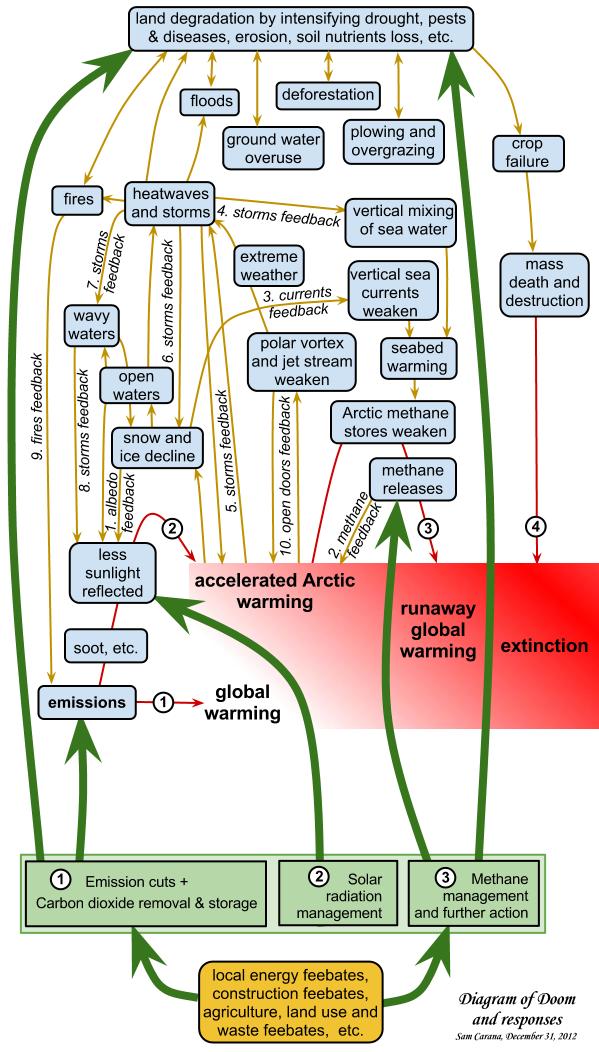Andrew Glikson
Earth and climate scientist
Australian National University
15.11.2019
The effects of encroaching deserts and of fire storms on terrestrial forests originally developed under moderate conditions distinct from those emerging under rapid global warming and extreme weather events may have been underestimated. Average global temperatures do not tell the story — it is the increasingly frequent weather anomalies which do. Powerful psychological factors prevent many scientists from expressing their worst fears, a phenomenon dubbed as “scientific reticence”.
As the tropical climate zones expand toward the poles, moderate climate zones shift polar-ward and are contracting where they clash with polar-derived cold air and ice melt water flow through weakened jet stream boundaries. As climate zones are shifting at a rate of 56-111 km per decade and ecosystems have only a short time to adapt, arid zones expand and droughts and fires consume the moderate-climate forests and formerly fertile habitats. Allen et al. (2012) suggest the increase in black carbon aerosols and tropospheric ozone constitute significant factors generating a polar-ward shift of moderate climate zones.
Global fire maps by NASA document the progression of wildfires since about 2000, including major fires in Siberia, northwest Europe, southern Europe, Russia, Southeast Asia, Australia, central and southern America, California and elsewhere (Fig. 1).
 |
| Figure 1. The Moderate Resolution Imaging Spectro-radiometer (MODIS) on NASA's Terra satellite showing fires around the world. Credit: NASA |
Many scientists and the IPCC have underestimated the scale and rate of global warming and its consequences. With exceptions, the need for excessive caution and absolute certainty in science is often manifested in reticence from the mainstream science (‘Down to Earth’ 2019). However, the available evidence suggests that scientists have in fact been conservative in their projections of the impacts of climate change and at least some of the key attributes of global warming from increased atmospheric greenhouse gases have been underpredicted, particularly in IPCC assessments of the physical science by Working Group I.
By contrast, at a speed hardly anticipated about 20 years ago, wildfires have been spreading around the globe over large parts of the continents.
Nor do average global land-ocean temperatures tell the whole story. It is the increasingly frequent anomalies which underlie extreme weather events (Fig. 2), including rapid Arctic melt, heatwaves, fires, storms and cyclones, which underpin the fundamental shift in the state of the terrestrial climate.
 |
| Figure 2. Temperature anomaly distribution: The frequency of occurrence (vertical axis) of local temperature anomalies (relative to 1951-1980 mean) in units of local standard deviation (horizontal axis). Area under each curve is unity. Image credit: NASA/GISS. |
 |
| Figure 3. Weather systems driven by the strong westerly winds of the Antarctic polar vortex curl over the southern continents (NASA, Galileo). |
 |
| Figure 4. Australia: Current effects of global warming. A. 2018 annual mean temperatures compared to historical temperature observations. B. 2018 annual rainfall compared to historical rainfall observations. |
 |
| Figure 5. Fires in Australia, November 8, 2019, NASA Worldview |
 |
| Andrew Glikson |
Earth and climate scientist
Australian National University
Books:
The Archaean: Geological and Geochemical Windows into the Early Earth
The Asteroid Impact Connection of Planetary Evolution
The Plutocene: Blueprints for a Post-Anthropocene Greenhouse Earth
Evolution of the Atmosphere, Fire and the Anthropocene Climate Event Horizon
Asteroids Impacts, Crustal Evolution and Related Mineral Systems with Special Reference to Australia
Climate, Fire and Human Evolution: The Deep Time Dimensions of the Anthropocene
From Stars to Brains: Milestones in the Planetary Evolution of Life and Intelligence




















